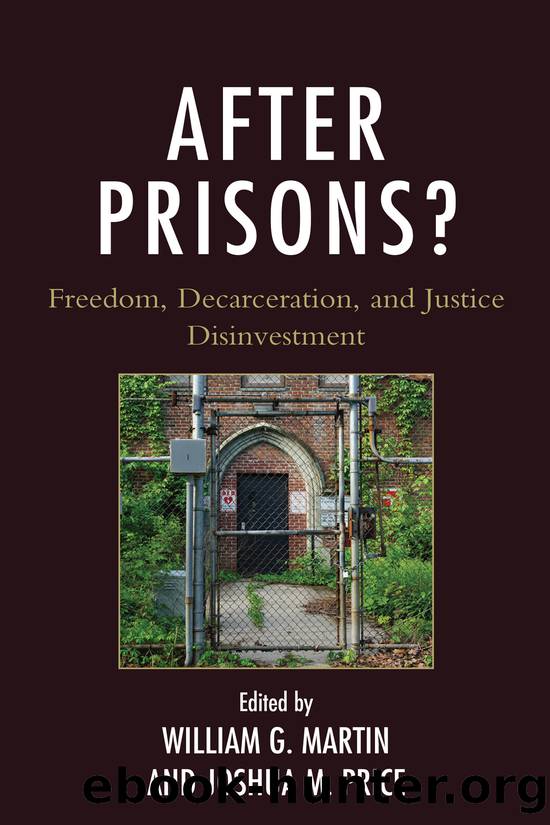After Prisons? by unknow

Author:unknow
Language: eng
Format: epub
Publisher: Lexington Books/Fortress Academic
Chapter 4
Serving Two Masters? Reentry Task Forces and Justice Disinvestment
Joshua M. Price
It is June, 2015, in Binghamton, New York.1 I am in my living room with two people Iâll call Jerry and Carol. Both have served time in jail and now they work for community-based organizations. I have known them for about ten years. Jerry listens attentively as Carol and I conduct an informal inquest into the county reentry task force. To call it an âinquest,â however, is premature: the patient is not yet dead. But it is weak and may be dying. Jerry, Carol and I collaborated with others to found the task force about six years ago. They are bitterly disappointed with the direction it has taken. After about forty minutes, Jerry remarks that the task force has failed to advocate for the formerly incarcerated. To illustrate, he describes his effort to start a campaign to âBan the Box,â or ban questions about previous criminal convictions from employment forms as a way to facilitate employment of people with a criminal record.
Ban the Boxâthat Iâd talked to [the local reentry coordinator] aboutâheâs just not interested in that because that requires canvassing the neighborhood and getting to know the neighborhood, and putting your neck out and giving your opinion on something. (fieldnotes 2015)
Jerryâs example of the unwillingness of a local reentry task force coordinator to take on the âBan the Boxâ campaign captures a tension at the heart of this chapter. No one can serve two masters. Yet this is precisely the dilemma that many reentry task forces, agencies, and organizations confront. Many promise to serve criminal justice goals to monitor, punish and assure public safety. Yet as Naomi Murakawa has shown, this emphasis on a right to public safety propelled the development of a racialized carceral state in the first place (Murakawa 2014, 3â4). It is not surprising, then, that the goals of keeping the formerly incarcerated under supervision and trying to prevent them from reoffending combine awkwardly with the larger aims of promoting the civil rights of the formerly incarcerated, advocating for criminal justice reform, and changing the social conditions that land people in prison in the first place. What unites these two tendencies is the objective of reintegrating people after incarceration so that they can lead healthy lives of civic participation. But this larger goal papers over deep divergences in the people it brings together.
The county-run task forces that one now finds throughout New York State are an example of how state authority has devolved to local control, engendering conflict and competition among actors in each county as they jockey for funds and power to oversee people who have just gotten out of prison. The professionalization and institutionalization of the task forces, moreover, has meant that reentry is less peer-oriented and more coercive than before; the shift signals a denial or reversal of participation by the formerly incarcerated (such as Jerry and Carol) at both a policy and a practical level. A related consequence has been a renewed focus on simply managing formerly incarcerated people, often aided by actuarial software.
Download
This site does not store any files on its server. We only index and link to content provided by other sites. Please contact the content providers to delete copyright contents if any and email us, we'll remove relevant links or contents immediately.
| Adult Children of Alcoholics | Alcoholism |
| Drug Dependency | Gambling |
| Hoarding | Obsessive Compulsive Disorder (OCD) |
| Sexual | Smoking |
| Substance Abuse | Twelve-Step Programs |
The Hacking of the American Mind by Robert H. Lustig(4338)
Right Here, Right Now by Georgia Beers(4167)
Fingerprints of the Gods by Graham Hancock(3964)
Goodbye Paradise(3761)
Bad Pharma by Ben Goldacre(3396)
Happiness by Matthieu Ricard(3020)
More Language of Letting Go: 366 New Daily Meditations by Melody Beattie(3002)
The Social Psychology of Inequality by Unknown(2987)
The Plant Paradox by Dr. Steven R. Gundry M.D(2581)
Drugs Unlimited by Mike Power(2564)
Confessions of a Shopaholic by Sophie Kinsella(2309)
Borders by unknow(2280)
Make Love Not Porn by Cindy Gallop(2080)
Dry by Augusten Burroughs(2072)
Stop Being Mean to Yourself: A Story About Finding the True Meaning of Self-Love by Melody Beattie(1964)
Getting Off by Erica Garza(1910)
Belonging by Unknown(1837)
Yoga and the Twelve-Step Path by Kyczy Hawk(1807)
Unmasking Male Depression by Archibald D. Hart(1783)
